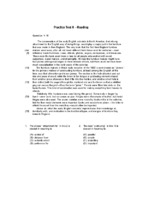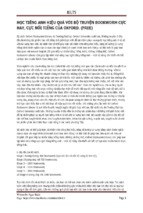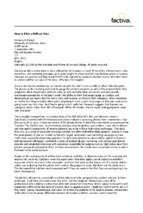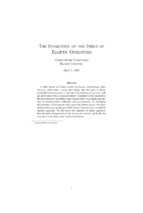Entrepreneurship, Finance, Governance and Ethics
Advances in Business Ethics Research
A Journal of Business Ethics Book Series
Series Editors
Deborah C. Poff, Brandon University
Alex C. Michalos, Brandon University
Editorial Board
Stephen Brammer, University of Bath
E. Holly Buttner, University of North Carolina at Greensboro
Nobuyuki Chikudate, Asia University
Michelle Greenwood, Monash University
Simon Shun-Man Ho, University of Macau
Kit-Chun Joanna Lam, The University of Hong Kong
Thomas Maak, ESADE Business School
Gedeon J. Rossouw, University of Pretoria
Scott Vitell, University of Mississippi
For further volumes:
http://www.springer.com/series/8805
Robert Cressy • Douglas Cumming • Chris Mallin
Editors
Entrepreneurship, Finance,
Governance and Ethics
Editors
Robert Cressy
School of Business
University of Birmingham
Birmingham, United Kingdom
Douglas Cumming
Schulich School of Business
York University
Toronto, Ontario
Canada
Chris Mallin
Norwich Business School
University of East Anglia
Norwich, UK
ISBN 978-94-007-3866-9
ISBN 978-94-007-3867-6 (eBook)
DOI 10.1007/978-94-007-3867-6
Springer Dordrecht Heidelberg New York London
Library of Congress Control Number: 2012951481
# Springer Science+Business Media Dordrecht. 2013
This work is subject to copyright. All rights are reserved by the Publisher, whether the whole or part
of the material is concerned, specifically the rights of translation, reprinting, reuse of illustrations,
recitation, broadcasting, reproduction on microfilms or in any other physical way, and transmission or
information storage and retrieval, electronic adaptation, computer software, or by similar or dissimilar
methodology now known or hereafter developed. Exempted from this legal reservation are brief excerpts
in connection with reviews or scholarly analysis or material supplied specifically for the purpose of being
entered and executed on a computer system, for exclusive use by the purchaser of the work. Duplication
of this publication or parts thereof is permitted only under the provisions of the Copyright Law of the
Publisher’s location, in its current version, and permission for use must always be obtained from
Springer. Permissions for use may be obtained through RightsLink at the Copyright Clearance Center.
Violations are liable to prosecution under the respective Copyright Law.
The use of general descriptive names, registered names, trademarks, service marks, etc. in this
publication does not imply, even in the absence of a specific statement, that such names are exempt
from the relevant protective laws and regulations and therefore free for general use.
While the advice and information in this book are believed to be true and accurate at the date of
publication, neither the authors nor the editors nor the publisher can accept any legal responsibility for
any errors or omissions that may be made. The publisher makes no warranty, express or implied, with
respect to the material contained herein.
Printed on acid-free paper
Springer is part of Springer Science+Business Media (www.springer.com)
Contents
1
Overview . . . . . . . . . . . . . . . . . . . . . . . . . . . . . . . . . . . . . . . . . . . . .
Robert Cressy, Douglas Cumming, and Chris Mallin
Part I
2
3
4
5
1
Entrepreneurship, Venture Finance and Ethics
The Value of Country-Level Perceived Ethics to Entrepreneurs
Around the World . . . . . . . . . . . . . . . . . . . . . . . . . . . . . . . . . . . . . .
April Knill
15
Do Private Equity-Backed Buyouts Respond Better
to Financial Distress than PLCs? . . . . . . . . . . . . . . . . . . . . . . . . . .
Robert Cressy and Hisham Farag
49
Philanthropic Venture Capitalists’ Post-Investment Involvement
with Portfolio Social Enterprises: What Do They Actually Do? . . .
Mariarosa Scarlata and Luisa Alemany
75
Law and Corruption in Venture Capital and Private Equity . . . . .
Douglas Cumming, Grant Fleming, Sofia Johan, and Dorra Najar
Part II
87
The Impact of Regulation and Financial Structure
on Ethics and Governance
6
The Development of the UK Alternative Investment Market:
Its Growth and Governance Challenges . . . . . . . . . . . . . . . . . . . . . 113
Chris Mallin and Kean Ow-Yong
7
Controlling Shareholders’ Fiduciary Duties Owed to Minority
Shareholders – A Comparative Approach: The United States
and France . . . . . . . . . . . . . . . . . . . . . . . . . . . . . . . . . . . . . . . . . . . 137
Celine Gainet
v
vi
Contents
8
Harmonized Regulatory Standards, International Distribution
of Investment Funds and the Recent Financial Crisis . . . . . . . . . . . 175
Douglas Cumming, Gael Imad’Eddine, and Armin Schwienbacher
9
Active Management of Socially Responsible Portfolios . . . . . . . . . . 213
Annalisa Fabretti and Stefano Herzel
10
A Socially Responsible Portfolio Selection Strategy . . . . . . . . . . . . 237
Stefano Herzel and Marco Nicolosi
Part III
Ethics, Fraud and Managerial Decisions
11
Corporate Social Responsibility Boundaries . . . . . . . . . . . . . . . . . . 255
Celine Gainet
12
Voluntary and Mandatory Skin in the Game: Understanding
Outside Directors’ Stock Holdings . . . . . . . . . . . . . . . . . . . . . . . . . 273
Sanjai Bhagat and Heather Tookes
13
The Causes and Financial Consequences of Corporate Frauds . . . . 295
Stefano Bonini and Diana Boraschi-Diaz
14
Corporate Governance and Business Strategies for Climate
Change and Environmental Mitigation . . . . . . . . . . . . . . . . . . . . . . 315
Raj Aggarwal and Sandra Dow
Part IV
Ethics and Governance in China
15
The Role of Mutual Funds in Deterring Corporate
Fraud in China . . . . . . . . . . . . . . . . . . . . . . . . . . . . . . . . . . . . . . . . 343
Wenxuan Hou, Edward Lee, and Konstantinos Stathopoulos
16
Institutional Shareholders and Executive Compensation:
An Ethical View . . . . . . . . . . . . . . . . . . . . . . . . . . . . . . . . . . . . . . . 363
Shujun Ding, Chunxin Jia, Yuanshun Li, and Zhenyu Wu
17
Management Buyouts and Board Transformation in China’s
Transition Economy . . . . . . . . . . . . . . . . . . . . . . . . . . . . . . . . . . . . 389
Mike Wright, Yao Li, and Louise Scholes
18
Multiple Large Shareholders and Joint Expropriation
with Dividend Payments . . . . . . . . . . . . . . . . . . . . . . . . . . . . . . . . . 415
Huaili Lv and Wanli Li
About the Authors . . . . . . . . . . . . . . . . . . . . . . . . . . . . . . . . . . . . . . . . . 443
Index . . . . . . . . . . . . . . . . . . . . . . . . . . . . . . . . . . . . . . . . . . . . . . . . . . . 451
Chapter 1
Overview
Robert Cressy, Douglas Cumming, and Chris Mallin
Financial bubbles have regularly grown, burgeoned and burst many times in
the history of the world. One needs only to mention the British South Sea bubble
of 1720, the Dutch Tulip bubble of 1637, the Wall Street Crash of 1929, the Dot
Com bubble of 1998–2000, and the mortgage securitization bubble of 2007, to raise
a wry smile on the faces of those addressed. Whilst the bubbles were essentially
based on financial market and real estate speculation, they had serious ‘real
economy’ consequences. Such aftermaths varied in length and intensity depending
on how widespread and deep they were (Knidleberger and Aliber 2005). But whole
economies were often afflicted and in 1929 much of the world, was thrown into
depression when the 1920s bubble finally burst. Galbraith (1961) writing about the
1929 crash and its decade long aftermath of global depression, noted that ‘There is
an essential unity in economic phenomena; no Chinese Wall separates the fiduciary
from the real’. But because of the lack of ‘system memory’ (in the 1990s we had a
decade of ‘Rational expectations’ monetarism in which producers and consumers
were endowed with perfect foresight and the money supply ‘merely’ influenced
the price level), the global spread of the celebrity culture, closer global integration
of markets and lightening speed of information transmission, the effects of the
boom-bust cycle have been in recent times no less than cataclysmic (Ferguson et al.
2007). Nor have the effects of the 2007 crash been fully experienced at the time of
writing (end-2011). Some believe we have just reached ‘the end of the beginning’
(Churchill 1942).
R. Cressy (*)
School of Business, University of Birmingham, Edgbaston Road, B15 2TY Birmingham, UK
e-mail:
[email protected]
D. Cumming
Schulich School of Business, York University, Keele Street 4700, M3J 1P3 Toronto, ON, Canada
e-mail:
[email protected]
C. Mallin
Norwich Business School, University of East Anglia, Norwich NR4 7TJ, UK
e-mail:
[email protected]
R. Cressy et al. (eds.), Entrepreneurship, Finance, Governance and Ethics,
Advances in Business Ethics Research: A Journal of Business Ethics Book Series 3,
DOI 10.1007/978-94-007-3867-6_1, # Springer Science+Business Media Dordrecht 2013
1
2
R. Cressy et al.
A key feature of all such financial bubbles is the growing role of greed and
corruption facilitated by the unbridled growth of credit to consumers and businesses and the destruction of consumer and business confidence that follows them.
Recent history is instructive in this respect. A root cause of the Wall Street crisis of
1929 and the decade of global depression that followed in its wake, was the role of
leverage. Leverage in ‘The roaring 20s’ took the form of borrowing to finance
house price purchases and stock market investments, be it in the form of bank
borrowing (for mortgages or for high beta stock portfolios) or simply very low
margin requirements on transactions. Before long, speculation soon takes hold so
that goods (particularly houses and stocks) are bought not for their own fundamental values but for the simple reason that their prices are expected to rise (Shiller
2005). Prevailing economic theory seems to be no guide in these times because
its assumptions (perfectly functioning markets reflecting fundamental values) are
progressively eroded. Indeed so false are these assumptions nearing the peak of a
boom, they take on the mischievous status of a religion when there is no God to
support these beliefs. Soros (2008) has documented very well the entirely legal
manipulation of financial markets that takes place during short- and long-term
Boom-Bust cycles.
In our own time and in line with most, if not all, financial crises (Knidleberger
and Aliber 2005) at the heart of the high tech boom and bust of the year 2000,
the global 2008 financial crisis was a series of iconic corrupt practices. The
most infamous of these in the Dot Com bubble (Cassidy 2002) was the corrupt
accounting and other practices at the US energy giant Enron which, when whistleblown in 2001, resulted in the then biggest corporate collapse in history, involving
over $50 billion of losses to share- and bond-holders not to mention customers and
suppliers. In that year Enron, a company heralded as ‘America’s best run company’
for a decade and garlanded by the likes of Time, Business Week and Fortune
magazine, announced that it had overstated earnings in its accounts for the previous
4 years by over half a billion dollars. This news sent its share price into free fall and
it filed for bankruptcy shortly after. The collapse of Enron also triggered the
collapse of its auditor and consultant, the global accounting firm Arthur Anderson.
Their role in keeping the illicit book-keeping at Enron under close wraps was
critical in the process of hoodwinking both the public and its investors. Cumming
and MacIntosh (2004) document many more of the fraudulent and/or corrupt
practices that occurred in the Internet boom.
An iconic corruption in the crash of 2007 was Bernie Madoff’s Ponzi US
scheme. A Ponzi scheme is an entirely bogus investment syndicate that, instead
of using new investor money to buy stocks, uses it to pay out dividends to existing
investors. In the Madoff case this syndicate boasted a constant (zero standard
deviation) return of 10% to its gullible investors for over a decade. The scheme
relied on the creation of confidence by a confidence trickster and on a long-term
booming stock market for its viability. Once this market turned significantly down,
returns could not be maintained, the scheme was exposed as a sham and its creator
as a fraudster. Madoff, the Director, had made an unimaginable $65 billion in elicit
profits over a 20 year stint and was subsequently incarcerated for 150 years for his
nefarious activities. Much of this money is unlikely ever to be found.
1 Overview
3
However one looks at it, the lack of strong corporate governance is another
essential ingredient in the boom-bust cycle. Why were these corrupt practices not
discovered earlier? What were the auditors doing? Was there proper control over
payments to Directors? And so on.
This book attempts to address empirically, and at the micro level, the role of
business ethics on performance, the extent of corporate corruption in various
economies in the world, the effects of corruption on company performance and
finally the measures governments might introduce to deal with the issues.
It has four parts dealing with respectively Entrepreneurship, Venture Finance
and Ethics (Part I), The Impact of Regulation and Financial Structure on Ethics and
Governance (Part II), Ethics, Fraud and Managerial Decisions (Part III) and Ethics
and Governance in China (Part IV).
Part I of the book examines the role of ethics and governance in entrepreneurship
and venture capital and private equity finance. There are four chapters that highlight
the importance of ethics and governance to the level and performance of entrepreneurial activity around the world (Chap. 2), the ability of investors to deal with
financial distress (Chap. 3), deal structure (Chap. 4), and investment fund structure
and performance (Chap. 5). These chapters show uniquely the relevance of ethics
and governance in entrepreneurship with reference to empirical data. The evidence
in Chap. 2 shows that ethics matters to entrepreneurs in different countries, and there
are big differences in ethical practices across countries. The evidence in Chap. 3
shows that private equity firms are better placed to deal with ethics and governance
issues for firms in financial crisis than other types of investors. The evidence in
Chap. 4 shows that private equity investors provide unique financing structures for
socially responsible businesses. Finally, Chap. 5 shows that ethics matters for how
private equity funds set up compensation structures in different countries around
the world, and which, in turn, drastically affects performance at the private equity
fund level.
More specifically, Chap. 2 by April Knill, “The Value of Country-level Perceived Ethics to Entrepreneurs Around the World,” examines the riskiness of
investing in private equity and the resulting importance of trust among private
firms that are subject to investor risk aversion. Using a dataset that spans 33
countries from 1998 to 2004, the author examines the impact of country level
ethical standards (based on two independent measures) on the performance and
outcome of private firms. The data show that entrepreneurial firm performance is
positively influenced by perceived country-level ethical standards. Knill’s evidence
and analysis leads to three main findings. Firstly, a higher level of ethics is associated with enhanced entrepreneurial financial performance measured by net sales
and net income. Secondly, a higher level of ethics is associated with an increased
efficiency of the entrepreneurial process, as evidenced by a shorter time to exit, a
lower probability that an entrepreneurial firm will remain private and an increased
probability that a firm will exit via acquisition. Thirdly, a higher level of ethics
enables entrepreneurial firms to exit via IPO at no additional cost measured by IPO
underpricing.
Chapter 3 by Robert Cressy and Hisham Farag, “Do private equity firms respond
better to financial distress than PLCs?” examines new private equity data on
4
R. Cressy et al.
buyouts that became financially distressed over the period 1995–2008. The authors
consider empirically whether private equity owned companies (buyouts) in financial
distress (Receivership/Administration) have better recovery rates for secured debt
than their publicly owned (PLC) counterparts. The data indicate that the recovery
rates of buyouts (amount recovered in proportion to total assets) are over twice that
of PLCs. Administration does not have an effect on debt recovery rates even though it
is a faster way to deal with distress. The authors consider other factors that affect
recover rates, including the number of creditors, company size and leverage. Finally,
the authors examine factors determining the time a firm spends in recovery and find
a significant effect of the recovery procedure used (Administration is shorter) and
the date of appointment of the Administrator or Receiver (later years have shorter
durations).
Chapter 4 by Luisa Alemany and Mariarosa Scarlata, “Deal Structuring in
Philanthropic Venture Capital Investments,” considers a new issue which has
received scant academic attention: philanthropic venture capital. Philanthropic
venture capital considers financing entrepreneurial ventures with the aim of maximizing the social return on the investment. Alemany and Scarlata examine the deal
structuring phase of philanthropic venture capital investments in terms of valuation,
security design and contractual covenants. Empirical evidence is provided for
Europe and the United States. The data examined emphasise that the ‘non-distribution constraint’ holding for non-profit social enterprises is an effective tool to align
the interests of both investor and investee. As a result, philanthropic investors are
more like stewards than principals. It is noteworthy that the same venture capitalists
structure their non-philanthropic investments in the same way as traditional venture
capitalists regarding moral hazard and other risks of investment.
Chapter 5 by Douglas Cumming, Grant Fleming, Sofia Johan and Dorra Najar,
“Law and Corruption in Venture Capital and Private Equity,” examines an international sample of venture capital and private equity funds to assess the role of
law, corruption and culture in setting fund manager fees. The authors provide
recent evidence from news and other media that fee setting in venture capital and
private equity organizations is rife with corruption and absence of legal scrutiny. By
examining an international sample of fees, the authors are able to compare various
determinants of fees, and to show that the data examined strongly indicate that
corruption, culture and legal settings are much more significant in determining
fees than fund manager characteristics and/or market conditions. In particular, the
authors show that in countries with better legal conditions, fixed fees are lower,
carried interest fees are higher, clawbacks are less likely, and share distributions
are more likely. Countries with lower levels of corruption have lower fixed
fees and higher performance fees, and are less likely to have clawbacks and cashonly distributions. They also show that Hofstede’s measure of ‘power distance’ is
negatively related to fixed fees and the use of cash-only distributions, but positively
related to performance fees and clawbacks. Furthermore, the authors examine
the impact of country differences in corruption and law quality on private equity
returns. To do this, the authors utilize a unique data set comprising over 750 returns
to private equity transactions across 20 developing and developed countries in Asia.
They find that the quality of the prevailing legal system (including legal protections
1 Overview
5
for investors) is positively related to returns. The main explanation for this finding
is that inefficient legal protections negatively impact transaction structures and
create economic uncertainty when VCs exit investments. However, the authors
also find that private equity returns are higher in countries with higher levels of
corruption. This finding is consistent with the view that private equity managers
bring about organizational change to alleviate the costs of corruption.
In summary, the data and analyses in Part I of this book provide a unifying theme
and complementary evidence from entrepreneurs, venture capital and private equity
investors that ethical issues are significant for the entrepreneurial process. Ethics
and governance influence the extent and performance of entrepreneurship. Private
equity investors are well placed to deal with governance problems in times of
financial distress. Venture capital and private equity investors are also influenced
by social responsibility in forming deal structures. Moreover, venture capital and
private equity funds enhance such deal structures in response to concerns over
ethics and corruption, which in turn impacts fund performance.
Part II of this book covers the topics that relate regulation and financial structure
to ethics and governance. Part II is comprised of five chapters pertaining to issues
of how mandated governance structures may contribute to improve ethical outcomes for newly listed companies (Chap. 6), the legal responsibilities of controlling
shareholders for minority shareholders (Chap. 7), the responsibilities of investment
fund managers voluntarily adopted legal standards to act responsibly and ethically
and investor demand for such self imposed governance standards (Chap. 8),
and portfolio management and portfolio selection of socially responsible investment portfolios (Chaps. 9 and 10, respectively). Chapter 6 shows that a nominated
advisor requirement for the junior stock exchange in London, the Alternative
Investment Market, may help mitigates issues of unethical behavior among newly
listed companies. Chapter 7 provides an in-depth legal analysis of the role of
majority shareholders to minority shareholders in a civil law (France) versus a
common law (United States) regime. Chapter 8 examines the role of investor protection in mutual funds with regard to the use of voluntarily adopted legal standards, and
explains how such standards are increasingly common across many countries around
the world, and the significant investor demand for the use of such standards around
the world, particularly after the recent financial crisis. Chapters 9 and 10 consider the
importance of portfolio management of socially responsible investment portfolios,
and how managerial practices change for socially responsible funds, as well as
portfolio selection.
In particular, Chap. 6 by Chris Mallin and Kean Ow-Yong, “The Development of
the UK Alternative Investment Market – Its Growth and Governance Challenges,”
examines the development of the UK Alternative Investment Market (AIM) since
it was launched in 1995 and its growth with over 1,200 companies currently listed.
The authors highlight potential pitfalls of the scant regulation on AIM which in turn
give rise to corporate governance and ethical issues. The authors examine the central
role of the nominated advisor (NOMAD) and the potential governance and ethical
implications. Finally, the authors discuss some of the concerns that AIM participants
have about the market, including recent scandals on AIM and discuss the implications of their results for academics, investors and policymakers alike.
6
R. Cressy et al.
Chapter 7, by Celine Gainet, entitled “Controlling Shareholders’ Fiduciary
Duties Owed to Minority Shareholders – A Comparative Approach: the United
States and France”, examines the duties, direct and indirect, that controlling shareholders have towards minority shareholders. Whereas controlling shareholder’s rights
are quite considerable, their duties by contrast tend to be very limited. This chapter
shows that a balance between controlling shareholders’ rights and duties is needed and
analyzes the equilibrium developed in two legal systems: American common-law and
French civil law. Whereas controlling shareholders seem to be assigned more duties
in France than in the US, enforcement rules and case laws act to mitigate this fact.
Chapter 8 by Douglas Cumming, Gael Imad’Eddine and Armin Schwienbacher,
entitled “Harmonized Regulatory Standards, International Distribution of Investment Funds and the Recent Financial Crisis,” considers for the first time the impact
of fund regulation on the international distribution of investment funds. The authors
study the role of the 2001 UCITS Directive of the European Union, put in place to
mitigate fraud and promote investor confidence throughout the Union. The authors
examine the impact of UCITS on international distributions of European investment funds over the 2002–2009 period. The data examined indicate that the UCITS
regulatory structure has significantly facilitated cross-border fund distributions,
though UCITS has had less success in facilitating distributions among smaller
fund promoters. Also, UCITS funds, especially UCITS equity funds, are found to
have lost some of their advantages in enhancing cross-border distributions during
the recent financial crisis. Finally, the authors record a growing interest in UCITS
outside Europe, notably in Asia, in recent times.
Chapter 9, by Annalisa Fabretti, Stefano Herzel, entitled “Active Management
of Socially Responsible Portfolios,” considers the problem of an investor who
wishes to allocate her wealth reflecting socially responsible (SR) criteria. The
reduction in the investment set opportunity that this involves produces a cost for
the investor which they call the “cost of sustainability”. The investor is aware
that the financial performance of actively managed SR portfolios may be better or
comparable to those of conventional portfolios. For this reason, the investor decides
to entrust her wealth to a portfolio manager able to produce accurate forecasts of SR
asset returns. The investor’s task is then threefold: (a) hiring a manager who can
offset the cost of sustainability; (b) setting a bonus to compensate the manager for
the investment restriction; (c) attracting only the best and more motivated managers
to the task. They devise a theoretical solution to these problems and apply their
results to data from the S&P500 firms which are screened by KLD scores.
Chapter 10, by Stefano Herzel and Marco Nicolosi entitled “A Socially Responsible Portfolio Selection Strategy”, proposes a new theoretical methodology to
integrate Socially Responsible (SR) standards into the process of investment
decisions. They use SR scores of companies in the S&P500 and in the Domini
Social Index (DSI) to define the level of SR of a portfolio. They model this as a
linear combination of the SR scores of the single stocks with coefficients given by
the portfolio’s weights. Portfolios are formed that minimize the tracking error from
the DSI whilst at the same time improving the SR measure. The analysis of the
performances of the portfolios show that the improvement of the SR is usually
1 Overview
7
possible at a small cost in terms of tracking error, and that the enhanced portfolios
produced, in most of the cases, better financial performance than the benchmark.
In summary, Part II of this book provides new theory and empirical evidence on
a causal link between regulation, improved governance and ethical outcomes for
the investment industry. These links are evidenced in the market for newly public
firms, particularly those on junior stock exchanges (Chap. 6), in legal obligations
for majority to minority investors (Chap. 7), in voluntarily adopted legal standards
for mutual fund governance, investment portfolio management (Chaps. 8 and 9)
and in investment portfolio selection (Chap. 10).
Part III of this book considers topics on ethics, fraud and managerial decisions.
It comprises four chapters that deal with issues pertaining to ethical issues surrounding
managerial decisions, including the scope of social responsibility for firms (Chap. 11),
directors’ equity stakes in their companies (Chap. 12), the decisions of managers
to engage in unethical behavior (Chap. 13), and the decisions of managers to engage
in climate control and environmental mitigation (Chap. 14). Chapter 11 examines
various forces, such as competition, that influence the extent of managers engagement
with social responsibility. Chapter 12 explores the role of directors’ equity holdings
in the companies with which they are associated in terms of managerial decisions and
in turn the impact of these decisions on firm performance. Chapter 13 examines
determinants of managerial fraud and the subsequent consequences of such fraud.
Finally, Chap. 14 considers managerial responses to changes in physical climate and
environmental focussing on the largest publicly traded companies in the world.
Specifically, Chap. 11 by Celine Gainet, entitled “Corporate Social Responsibility
Boundaries” addresses the dilemma that companies face between what society as a
whole demands and the necessity of being economically efficient. Why do only
some companies claim they act in a socially responsible way? Because of international competition, policy makers do not act to improve environmental, social and
societal issues until it becomes socially necessary, and companies act in a socially
responsible way when social necessity is combined with a globally low reputation.
Chapter 11 provides a theoretical insight into the roles of companies within a
society. It addresses the legitimacy of companies in creating a green world under
the constraint of maintaining democratic structures. To be legitimate in social
actions they undertake privately, companies should go through a corporate politicization process.
Chapter 12 by Sanjai Bhagat and Heather Tookes, entitled “Voluntary and
Mandatory Skin in the Game: Understanding Outside Directors Stock Holdings,”
examines the determinants of equity ownership by outside directors and the relationship between ownership and operating performance. The authors make use of
ownership requirements to shed light on the determinants of director holdings and
to separate voluntary from mandatory holdings of directors. The analysis shows that
mandatory holdings are unrelated to future performance, which is consistent with
the theory that ownership requirements reflect optimal ownership levels. By contrast, the analysis indicates that voluntary holdings are positively and significantly
related to future performance. This latter finding suggests that voluntary holdings
incentivize management.
8
R. Cressy et al.
In Chapter 13 by Stefano Bonini and Diana Boraschi-Diaz, “The Causes and
Financial Consequences of Corporate Frauds,” the authors reviewthe wave of
corporate scandals that has hit the market in the last decade, directing attention to
the effect of these events on shareholder value, corporate governance and stock
market reactions. Given this evidence a growing body of research has investigated
the determinants of corporate fraud, and the effects of such frauds on investors and
stakeholders wealth. It has attempted to identify channels of, and tools for, the early
detection of frauds and therefore ways to reduce the loss in social welfare. This
chapter provides a comprehensive view on the state of the current research on these
issues and provides directions for future research.
Chapter 14 by Raj Aggarwal and Sandra Dow, entitled “Corporate Governance
and Corporate Strategies for Climate Control and Environmental Mitigation,”
considers strategic corporate responses to climate change and other environmental
challenges. The authors suggest that these problems do not seem to fit in the
primary domain of corporate management as such decisions are often not seen as
profit-maximizing over the short run and are generally not consistent with executive
incentives. The authors challenge this view by analyzing 500 of the largest U.S.
firms to show that some climate change responses may indeed be firm valuemaximizing, and that such decisions can be expected to reflect the nature of a
firm’s corporate governance. Specifically, the authors document that institutional
ownership and board entrenchment significantly influence climate change mitigation and environmental impact policies of large firms.
In summary, Part III shows that managerial actions with an ethical dimension are
affected by the environment in which firms operate (Chaps. 11 and 14), their
ownership structure (Chap. 12), and have significant consequences for firm performance (Chaps. 12, 13 and 14). The evidence in Part III provides essential grounding
for understanding how and why managers engage in ethical behavior, and the
ethical consequences of managerial actions.
Part IV of this book covers ethics and governance in China. China is an interesting
country for which a separate section of this book is devoted for the following
reasons. Firstly, China is one of the fastest growing countries in a global context,
and recently has achieved the status of second largest country in terms of GDP. Its
global importance is no longer questionable. Secondly, popular press and conventional wisdom suggests that China’s spectacular success has come to some degree
at the expense of unethical conduct, such as the governing party’s tendency to
disregard the rule of law, the lack of political freedom and the lack of freedom of
the press. Thirdly, much of the economic power in China is held by the state, so
there are interesting unanswered questions regarding whether or not the stateowned companies are more ethical than their privately held counterparts. To this
end, Chap. 15 examines whether or not Chinese state-owned companies have a
governance role over mutual funds and are engaged in fraud in China. Chapter 16
considers executive compensation in China and its impact, if any, on ethics.
Chapter 17 considers management buyouts of publicly listed companies in China
and the effect of majority shareholders on minority shareholders and other governance issues. Chapter 18 considers controlling shareholders and dividend
1 Overview
9
payments among publicly traded companies in China. Taken together, these
chapters provide empirical evidence on the governance structures and outcomes
in one of the most important emerging countries in the world.
Specifically, Chap. 15, by Wenxuan Hou, Edward Lee and Konstantinos
Stathopoulos, entitled “The role of mutual funds in deterring corporate fraud in
China,” investigates whether mutual fund ownership deters corporate fraudulent
behavior among Chinese listed firms. While the existing literature on corporate fraud
in China has focused mainly on the impact of internal governance mechanisms,
limited attention has been paid to the effect of external governance mechanisms.
In China where investor protection and legal enforcement are relatively weak,
mutual fund ownership is expected to enhance the effectiveness of the stock market
to deter managerial expropriation. This is because mutual funds are institutional
investors that have more resources and expertise than individual investors that can
be used to monitor firm executives. The impact of mutual fund ownership in
deterring fraudulent activities is expected to be greater among Chinese listed firms
under private control than state control. This is because privately controlled firms
receive less financial support from the government and are more reliant on external
funding via the capital market. The authors confirm empirically the aforementioned
assertions. Their findings imply that mutual fund ownership and state ownership
generate offsetting corporate governance effects.
Chapter 16 by Shujun Ding, Chunxin Jia, Yuanshun Li and Zhenyu Wu is on
the topic: “Institutional Shareholders and Executive Compensation: An Ethical
View.” Institutional shareholders are shown to be effective monitors in curbing
executive compensation in mature capital markets. However this study which
presents findings from Chinese stock markets, and indicates the possible collusion
between institutional shareholders (e.g. mutual funds) and executives in publicly
listed companies. Mutual funds in China fail to serve as an effective monitoring
mechanism for executive compensation, suggesting that ethics has little role to play
when mutual funds and management of listed companies follow their self-interests.
Further analysis also demonstrates that, while bank-affiliated mutual funds are
no better monitors than non-bank-affiliated ones, joint-equity-bank-affiliated ones
are more effective monitors than state-owned-bank-affiliated ones.
Chapter 17 by Mike Wright, Yao Li, and Louise Scholes, entitled “Chinese
Management Buyouts and Board Transformation,” assesses the extent to which
MBOs of Chinese listed corporations enable a balance to be achieved in terms of
facilitating growth while maintaining the interests of other (minority) shareholders.
Using novel, hand-collected data from 19 MBOs of listed corporations in China,
the authors examine the extent to which boards are changed to bring in executive
and outside directors with the skills to grow and restructure a business. This is
contrasted with the extent to which outside directors become involved in developing
the business rather than fostering the interests of all shareholders. They find
little evidence that outside board members have the skills to add value to the MBO
firms. Boards appear to focus mainly on related-party transactions with some more
limited attention to growth strategies. Outside directors do not seem to openly
disagree with incumbent managers on the disclosure of their actions but may express
their views and exert pressure behind the scenes.
10
R. Cressy et al.
Chapter 18 by Huaili Lv and Wanli Li, “Multiple Large Shareholders and Joint
Expropriation with Dividend Payments,” studies the impact of multiple large
shareholders on dividend payments. This chapter examines the association between
cash dividends and the shareholders balancing mechanism (SBM) in China, using
alternative exogeneity and endogeneity assumptions regarding corporate ownership
structure. It explores, whether paying cash dividends is a means of protection for, or
involves the expropriation of, minority shareholders’ interests. The authors find
significant negative associations between cash dividend payments and the SBM of
non-controlling large shareholders under the exogeneity assumption, and the SBM
of tradable shareholders under the endogeneity assumption. The findings suggest
that cash dividends are used as a manner of ‘tunnelling’ by the controlling shareholder. It r also shows that the SBM of non-controlling shareholders has a significant positive effect on cash dividends, especially for companies paying abnormal
dividends. The results imply that in China’s capital market, cash dividend payments
not only play the role of expropriating minority shareholders’ interests by the
controlling shareholder, but also by the coalition of controlling and non-controlling
large shareholders. The findings confirm the tunnelling and joint expropriation
incentive of corporate dividend policy, and suggest that the presence of multiple
large shareholders doesn’t always alleviate firm’s agency costs and protect the
benefits of minority shareholders.
In summary, Part IV provides a unique and important perspective on ethics
and corporate governance in China. The unique evidence presented from China
deals with key topics in finance and ethics of interest to the world. These topics
include mutual fund governance, institutional ownership, management buyouts and
dividends. This work promises to pave the way for growing interest in the Chinese
economy in years to come.
Future research in the area of finance and ethics offers a wealth of opportunities
and unexplored issues with a global dimension. Firstly, with respect to the financing
of entrepreneurs, Part I of this book showed that entrepreneurship and finance and
ethics are inextricably linked by the activities of venture capital and private equity
investors. But how important is ethics to other types of investors, such as banks or
business angels in different countries? Do these differences depend on institutional
and legal conditions in these countries? What is the impact of such differences on
self-selection into entrepreneurship and does it affect entrepreneurial outcomes in
terms of real growth, patents, and financial performance?
Secondly, with respect to financial regulation, governance and ethics, Part II of
this book showed that regulation has important implications for ethics in newly
public firms, for minority shareholder protection, and for the funds management
industry. At the time of preparation of this book t recent changes in global regulation, including items pursuant to changes in MiFID rules in Europe, and DoddFrank rules in the United States, give rise to a wealth of unexplored empirical
issues that are the subject of follow-up work. More specifically, future work might
examine and quantify the costs and benefits of regulatory changes to influence
ethical conduct and fraud mitigation. The changes that have been happening around
the world provide a rich laboratory of natural experiments for which empirical
1 Overview
11
studies might shed much light; for example, on optimal regulatory design in the
financial services industries.
Thirdly, in respect of managerial actions and ethics, Part III of this book
provided much evidence that managerial actions are influenced by their institutional and economic environment. Moreover, the chapters in Part III showed
significant consequences of managerial incentives for ethical conduct. Future
research might examine in more detail precisely how ethical managers are selected,
how internal organizational structures impact ethical conduct over time, and
how managers with different characteristics respond to changes in economic
circumstances and regulation. To this end, there are rich opportunities for future
work that combines empirical methods and theoretical perspectives across a multitude of disciplines in ethics, management, law, finance and beyond.
Finally, regional analyses also provide fruitful laboratories for studying ethical
conduct. In this book we have provided one such regional focus, namely on China,
now one of the fastest growing most important economies in the world. To be sure,
there is ample scope for more work on fraud and ethics in China. For instance, future
applied scholars might examine the effectiveness of market design changes to
enhance governance in companies on the Shanghai and Shenzhen stock exchanges.
and market manipulation by investors in these markets. Other empirical work could
examine regional differences in entrepreneurship and ethics in China. More generally, future work might address these issues in developed and developing countries
across the world.
The complementary nature of the contributions presented in this book is testament to the quality of the authors’ work. As Editors, we have not only learned a great
deal from reading these 18 chapters, but we have also enjoyed immensely the
process of corresponding with the authors. We would therefore like to express our
gratitude to the contributors for their excellent and timely contributions to this book.
References
Cassidy, J. 2002. Dot.con: How America lost its mind and money. New York: HarperCollins.
Churchill, W. 1942. The end of the beginning. Speech delivered 20 November 1942.
Cumming, D.J., and J.G. MacIntosh. 2004. Boom, bust and litigation in venture capital finance.
Willamette Law Review 40: 867–906.
Ferguson, R., P. Hartmann, F. Panetta, and R. Portes. 2007. International financial stability. Draft
report prepared for ICMB conference, Geneva, 3–4 May.
Galbraith, J.K. 1961. The great crash 1929. New York: Pelican Press.
Knidleberger, C.P., and R. Aliber. 2005. Manias, panics and crashes: A history of financial crises,
5th ed. Hobeken: Wiley Press.
Shiller, R. 2005. Irrational exuberance, 2nd ed. Princeton: Princeton University Press.
Soros, G. 2008. The new paradigm for financial markets: The credit crisis of 2008 and what it
means. New York: BBS, Public Affairs.
Part I
Entrepreneurship, Venture
Finance and Ethics
Chapter 2
The Value of Country-Level Perceived Ethics
to Entrepreneurs Around the World
April Knill
Introduction
Following the “Great Recession” in 2007, there was a collective call by U.S.
investors for increased disclosure by private equity funds and venture capitalists
(VCs). Supporting these calls for regulation, a study by Cumming and Knill (2012)
finds that enhanced levels of securities laws enforcement (such as disclosure)
increase the supply and demand of VC, and enhance the likelihood that the portfolio
companies will exit via IPO – the most desired mode of exit.1 Although the final
version of the bill going through U.S. Congress was reworded to exclude VCs and
funds smaller than $100 million,2 the white elephant in the room remains. Investors
still don’t trust financial institutions and this distrust will likely permeate the private
equity arena since VCs and other private equity investors are notoriously tightlipped in their strategies/investments. This collective dearth of trust leaves room
for credible ways companies can signal their value and integrity to gain the trust
necessary for investors to take the plunge of investing, especially in an entrepreneurial firm. It further begs the question whether the ethics of the average firm in a
country can benefit entrepreneurs, who are at an increased risk of failing, in that
same country.
This chapter examines the relationship between country-level indicators of perceived ethics and the performance as well as outcome of private firms. The paper has
three main findings. First, a higher level of ethics is associated with enhanced
entrepreneurial financial performance. This positive relationship is largely robust to
1
The other mode of exit examined in this chapter is via mergers/acquisition.
Though as of May 12, 2010, Senator Jack Reed (Democrat – Rhode Island) is pushing to include
private equity and venture capital funds as well, which would force them to either register and
open their books to state regulators, or register with the Securities Exchange Committee. Source:
http://dyn.politico.com/printstory.cfm?uuid¼83766275-18FE-70B2-A8A84F19C017C8C6
2
A. Knill (*)
Department of Finance, College of Business, Florida State University, Tallahassee, FL, USA
e-mail:
[email protected]
R. Cressy et al. (eds.), Entrepreneurship, Finance, Governance and Ethics,
Advances in Business Ethics Research: A Journal of Business Ethics Book Series 3,
DOI 10.1007/978-94-007-3867-6_2, # Springer Science+Business Media Dordrecht 2013
15
16
A. Knill
the definition of ethics and two proxies for financial performance: net sales and
net income (both scaled by total assets). Second, the paper finds that higher levels of
ethics are associated with an increased efficiency of the entrepreneurial process, as
evidenced by a shorter time to exit. Specifically, higher levels of ethics are associated
with a decreased probability that an entrepreneurial firm will remain private and an
increased probability that a firm will exit via acquisition. Last, those entrepreneurial
firms in nations with higher levels of perceived ethics that are able to exit via IPO do so
at no additional cost. Explicitly, the underpricing of IPOs in nations with higher levels
of ethics is not significantly different than that in nations with lower levels of ethics.
Beginning with the corporate scandals of WorldCom and Enron, the pendulum
started swinging back toward finding value in ethics and integrity in business.
Society is showing a growing intolerance for greed, corruption, and profit without
a conscience (i.e., environmental concerns).3 Responding to this trend, universities
are adding ethics curriculum to their educational programs.4 During a time where
the greed of a few has resulted in devastation for many around the world, citizens
of many nations are looking for ethical corporate leadership on which they can
depend. This chapter may be of interest to managers of small businesses, who may
fear that an ethical approach to running a business might result in reduced competitiveness. In the same vein, the results may be of interest to VCs looking for investments; knowing that ethical behavior can lead to benefits with regard to financial
performance and the efficiency of the entrepreneurial process can help VCs to
critically evaluate both investments and global expansion opportunities. Lastly,
results may be of interest to regulators who are looking for a means of incentivizing
this critically important sector of the economy to take advantage of the benefits that
are afforded those that maintain a positive reputation and ethics.
This chapter is organized as follows. The next two sections provide motivations
for and against ethical behavior, providing a framework within which to perform
this study. The subsequent section “Data” provides detail on the data used. Thereafter the empirical method is described, followed by the main results and robustness
tests. The final two sections provide an analysis of limitations as well as potential
for future work, and conclusions.
Agency Theory and Ethics in Business
In their seminal 1976 work, Jensen and Meckling describe the pitfalls of the
separation of ownership and control that occurs when managers make decisions
about what to do with other people’s money. Around this same time, the term moral
3
Hamilton (1995), White (1995), Klassen and McLaughlin (1996), as well as Dowell et al. (2000)
all use event study methodology to show that firms with “greener” management practices have
superior stock price returns relative to firms with poor practices.
4
http://blogs.forbes.com/csr/2010/05/18/csr-and-the-job-hunt/




















